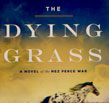 |
 |
11-21-08: 'The Horror Stories of Robert E. Howard' : Not a Biography
|
|
The Cthulhu Dining experience. |
Robert E. Howard is best known as the creator of Conan the Barbarian — and as well, perhaps, for his own unorthodox life. But Howard wrote a lot of work outside the Conan canon, much of it in the horror genre. Del Rey has embarked upon an ambitious program of reprinting Howard's work in quite nice trade paperback editions, perfectly suitable for corrupting young minds into the idea that reading is a pastime every bit as rewarding as video games, movies and skateboarding — everything short of sex. To this end, you might find that 'The Horror Stories of Robert E. Howard' (Del Rey / Random House ; October 28, 2008 ; $18.00) is possibly the best single volume choice for this task, combining Howard's ghost and Lovecraftian horror stories with some of his best barbarian-oriented short fiction. It's a smorgasbord of weirdness with a major theme of terror and variety across the board. What more could you ask for?
Just one little thing, and Del Rey has answered; that would be illustrations, lots of them, in this case by Greg Staples. Staples works in a variety of styles and Del Rey is quite generous – there's one and often more than one — for every story. The B&W reproductions are very nice, well laid-out and enhance the dark mood here quite well. There's a lot of variety of style as well. For example, the opening illustration for "The Children of the Night" is a lovely thirties-style pen & ink piece showing a group of men decked out thirties-style; but further on in the story, we see a murky and terrifying painterly-style vision of horror. Sure, such visions may make us long for color plates. Especially given the two cover images I've seen. My copy of the book has an image that that looks very much like something for Solomon Kane; but the image listed on the *.* copy showed a much cooler (to my monster-loving mind) piccie of someone about to get et by a very Cthulhu-like critter. Yummy, what's for dessert? That said, color plates might have doubled the price and corrupting young minds is best done at the lowest possible expense. I was corrupted by mass-market paperbacks, yes with Frank Frazetta covers, but still. I can only imagine the damage that might have occurred had I stumbled into something like this in the bookstore.
Of course, the majority of the damage is the result of the reading, and there's quite a bit of both variety and sheer volume in this collection. For a guy who's best known for his sword and sorcery fantasy, Howard wrote a lot of Lovecraftian horror. It's good stuff; Howard delivers the monsters with a little more explicit edge than Lovecraft and his other cohorts. Moreover, Howard's Lovecraftian work is not very often found in the Lovecraft & Friends collections, so having it all to hand in one volume (Illustrated! Nicely!) is trés cool. But Howard also wrote more traditional stories with ghosts and ghouls, and they're quite well-done. Finally of course, you've got your barbarian stories, with Bran Mak Morn featured in "Worms of the Earth". The chances are that if you’re reading this article, you'll consider this book essential. But it's better than essential; it's fun. I mean, illustrated Cthulhu mythos stories by Robert E. Howard — I'm bugging off work now and reading "Pigeons from Hell". How can I resist?
|
|
|
11-20-08: Previewing the Preview : Bruce Sterling's 'The Caryatids'
Bruce Sterling is a fascinating writer, with a complicated oeuvre that's all over the map. His anthology 'Mirrorshades' arguably created the cyberpunk genre. He's written prescient, meta-fictional masterpieces like "The Compassionate, The Digital" a short story that first appeared in Interzone, in which an artificial intelligence comes to consciousness steeped in the Islamic religion. He's written a wonderful series of caper comedies featuring Leggy Starlitz; 'Zeitgeist' is a great choice here, but any will do — theyre all a delight. I remember vividly being shaken out of this universe when I read 'Schismatrix'. 'The Difference Engine', his collaboration with William Gibson was a cornerstone for the "steampunk" genre that is now in the process of becoming a mainstream trope. But it's been five years since 'The Zenith Angle', his last science fiction novel.
Now, it's not exactly like he's been sitting on the sidelines. His essays, speeches and lectures have helped abolish and establish the boundaries of behavior on the Internet. He has a global influence. That said, I'm a guy who likes to read a science fiction novel now and again, and anything by Sterling zooms to the top of my list; in this case, 'The Caryatids' (Del Rey / Random House ; February 24, 2009 ; $25). Sure, you can look it up, and you'll find out that Caryatids are columns in the form of a woman, used as pillars to buttress ancient buildings; but the gist of the title refers to women who bear the brunt of Atlas; the women who hold the world on their shoulders. And alas, that all too often seems to be the case, while men, busy men, keep themselves occupied tearing things apart.
Sterling's novel is set about "a week after tomorrow" in science fiction terms; its near future, but not too near. Vera, Mila, and Sonja are identical clones with the skill set required to Save The World. That week after tomorrow world needs a lot of saving, what with the ravages of global warming, good ol' pollution (and you thought we were shut of it in the seventies, silly you!) and the worst scourge ever the pillage the earth — politics. The three women are not in fact quite human, and their relationships are correspondingly complex. How can three inhuman humans sweep the sand back into the human tide that overruns the earth? We need Bruce Sterling to answer that question.
Sterling's novel is an astonishing success on two very different levels. On one hand, as a thought-provoking work of speculative fiction, it'll blow your brains out. Sterling works equally well in the dark and the light, so that he can see both the unexpected apocalypse and the even more unexpected means with which to avoid said apocalypse. He writes with humor and verve, riding the edge of reality where yesterday's satire is tomorrow's reality. Big ideas bounce around, not as lectures, but as playful fun. For Sterling, a set-piece is both visually and conceptually driven. While you can't predict the future, you can indeed predict the hell out to the present. We may not end up in Sterling's future, but wherever we do end up, it's a good bet we'll encounter many of the concepts on display in this novel. Sterling writes science fiction that is entertainingly mind-boggling, but notr self-conscious.
But for any of this to be of more than discursive interest, you need an emotional connection. Sterling has the knack of making his characters poignantly real. There's a lovely tragic arc at work here, the kind that deserves a good violin concerto. You'll meet people you feel you know, both for better and worse, in this novel. And the better ones may just break you heart. For all the prescient technological intelligence and vision on display here, Sterling's best prediction is the stuff of any great novel; the future may be or do many things — but is most likely to break your heart.
|
|
|
11-19-08: Chip Kidd's 'Bat-Manga : The Secret History of Batman in Japan' : Origin Story
• 'Bat-Manga' on NPR's
Day to Day'
• Book Review
• Chip Kidd Interview
• Anne Ishii Interview
Today, we're looking at Chip Kidd's 'Bat-Manga : The Secret History of Batman in Japan' on three fronts; of course we have a review of the book, but I also want to talk about it here in the Commentary because there are things to say about it that are not necessarily germane to the review. We also have an in-depth interview with the author. But let me start with a confession; I'm not a fan of Batman comics or manga. I'm sure they have their virtues, but in general I'd prefer to spend my time staring at text. But when I first opened 'Bat-Manga', it literally brought tears to my eyes. A few glimpses at these pages told me something that words could not express. It was the same kind of reaction that smell can evoke, that instant immersion in memories of events that you may never have experienced.
Beyond the content, some of the most important aspects of a book like this are the production values. It's one thing to promise Batman comics we've never seen, and it's another to photograph ancient sheets of decaying paper with crystal clarity. And it's yet another to mount such work not in the dry presentation of a boredom-inducing archive, but instead, to offer the panels as if there were a surround-sound, IMAX movie. At $30, 'Bat-Manga : The Secret History of Batman in Japan' is not an inconsiderable investment, but, once you hold it in your hand, I dare you to put it down again; and I can practically guarantee that should you bring it home and leave it in plain sight few will be able to pass it by and none will be able to resist its charms. It's another cute pound puppy of books. But even though it is a manga, it really doesn't have the big cute puppy eyes. Those will be your eyes as you read.
|
|
|
11-18-08: Dan Simmons Exhumes Dickens and 'Drood' :
Darker Than Thou
When last I spoke with Dan Simmons, he told me about his forthcoming book, 'Drood' (Little, Brown / Hachette ; February 9, 2009 ; $26.99), the story of Charles Dickens' last days, when he took a turn towards the darkness. The ARC has just arrived, and like his last novel, 'The Terror' this is a long and complex historical novel shot through with undertones and overtones of the fantastic. You're looking at 773 pages, but let me assure you readers that page 1 will grab you so surely, take hold and never let go that this is quite possibly going to overwhelm the success of the 'The Terror', which at least in the San Francisco Chronicle was in the bestseller list. I actually thought that 'The Terror' was one of the best, if not the best Dan Simmons novel. It was so densely textured, so well executed and so brilliantly imagined that for me it even outshone genre classics like 'Hyperion' and 'Song of Kali' — or at least it certainly gives them a run for the money.
Simmons has managed to shape himself one of the quirkiest careers in American letters, ever. He's said it many times; if has was up to 'Hyperion Sequel # 24' he'd be bathing in the buckets of money. Everybody would know he wrote science fiction and there'd be no confusion. But Simmons just writes what interests him, and we can be thankful he finally got around to looking into Dickens. Now, it's interesting that he started out his literary life as something of a heretic so far as Dickens is concerned; but then, not everybody is as marked by Dickens, perhaps as I was. I read 'Great Expectations' when I was madly in love and decidedly in college and recall sitting in grassy fields that surrounded UC Irvine at the time (theyre now strip malls, parking lots and skyscrapers housing queasy financial firms), and disappearing into the golden fields and gray tenements of Dickens' world. It was a place more real than the place I was in.
That wasn't Simmons' experience, but no matter. His novel may not have the golden aura, but it's got the dank, dark and dangerous layered so finely that readers will disappear into a world considerably less convivial than those we generally associate with Dickens — and those are none too friendly themselves.
The premise of Simmons' novel is that something happened to Dickens that made him want to write 'The Mystery of Edwin Drood', and it wasn't a happy circumstance. The story is told by his friend, competitor and collaborator, Wilkie Collins; the manuscript has been "hidden" all these years at Collins' request. Like 'The Terror', much of this novel is based on historical facts, and much of the pleasure comes from Simmons' ability to use the fictional tropes and even some of the styles of the period he's set the novel in to write the novel. But then there is just the pure pleasure of such an immersive, massive novel, helped along by Simmons' gift for suspenseful plotting. And of course, his ability to add just the right amount of the fantastic into the mix, something both Dickens and Collins were adept at as well.
Now, in case you've been hiding under a rock, there's another exciting bit about this book, which is that Guillermo del Toro, who will provide a cover blurb is also interested in directing this filmed version soon after he finishes 'The Hobbit'. Now, I'll believe the movie when I buy the ticket, but in the interim it does demonstrate some faith in what is admittedly a rather unusual literary property. Of course this is what we've come to expect from Dan Simmons — the unexpected.
|
|
11-17-08: James P. Blaylock Joins 'The Knights of the Cornerstone' :
A Veil of Secrecy
Style is impossible to quantify and easy to identify. It's been ages since I read a James P. Blaylock novel. I know, he's been busy in the small presses, but those regular, one-a-year novels have been out of the picture — until now. On the face of it, one might be tempted to think that 'The Knights of the Cornerstone' (Ace / Penguin Putnam ; December 2, 2008 ; $23.95), which posits some latter-day Knights Templar holed up in the mountains of California, is yet another of the latter-day treasure hunts that have been the bread and butter of publishers hoping to replicate the success of that book. But it's a matter of style, and anyone who knows Blaylock can identify his homespun, suburban-style prose from the first words of the first sentence. Yes, we're back home again, where the people are weird as reality itself.
"Calvin Bryson read the letter for a third time, but for some reason it insisted on saying the same thing it had said the other two times." The letter in question is an invitation to visit his aunt and uncle — Al and Nettie Lymon, and it arrives on the same day as a veil worn by his long-dead Aunt Iris, who wore it when she conducted séances. Calvin has the task of taking the veil to his aunt and uncle, in the process of which he'll meet a variety of characters who will remind readers of people they know — those weirdoes who seem sort-of nice but also creep you out a bit. In Blaylock's surreal world, some are simply strange and some are dangerous, but they're all people who might show up in a shopping mall parking lot, or maybe at a high-school football game.
Blaylock has a talent for conjuring magic in a manner that make sit seem real and plausible, with rules that are broken and breaches in the reality we know. You'll note a rare honor in the blurbs listed on the back — there's one from Philip K. Dick, which is itself like something that would happen in a Blaylock or Dick novel. Blaylock, along with K. W. Jeter, Dean Koontz and Tim Powers, used to hang out with Dick in Santa Ana, and it was then that he was writing stuff like 'Homunculus', which gets resurrected and collected in 'The Adventures of Langdon St. Ives' (Subterranean Press ; November 30, 2008 ; $38). This is steampunk done in the finest style one can hope for; goofy, fun writing laced with shots of real horror and lavishly illustrated by J. K. Potter, which alone would place it in the must-buy bin. Sure, you, like me, may have the weird old boxed set of some of these books, and even the Arkham House original from whence the cover image comes. But Sub Press rules, and having 500 pages of fun just can't be denied. In a sense, then, 'The Knights of the Cornerstone' proves to be one of those treasure-hunt books; only in this case, the treasure to be found is the writing of James P. Blaylock. |
|
|
|
|
|
|
|
 |
|
|
|




